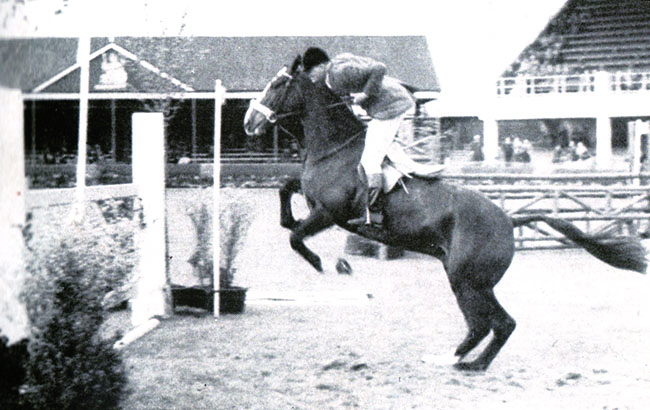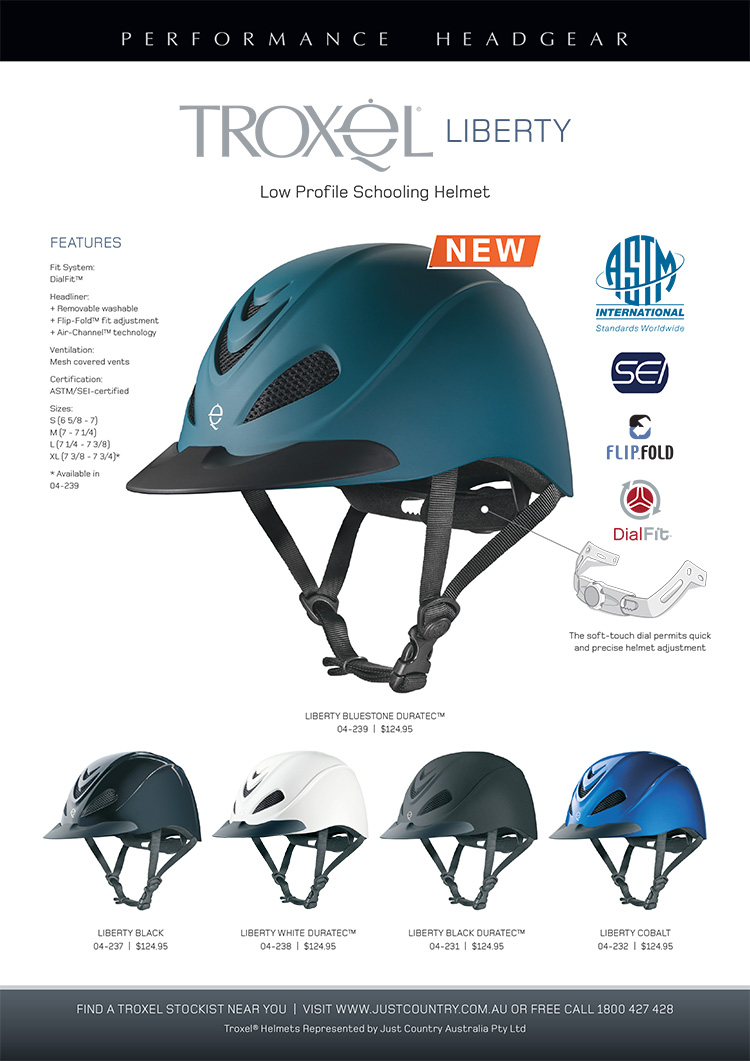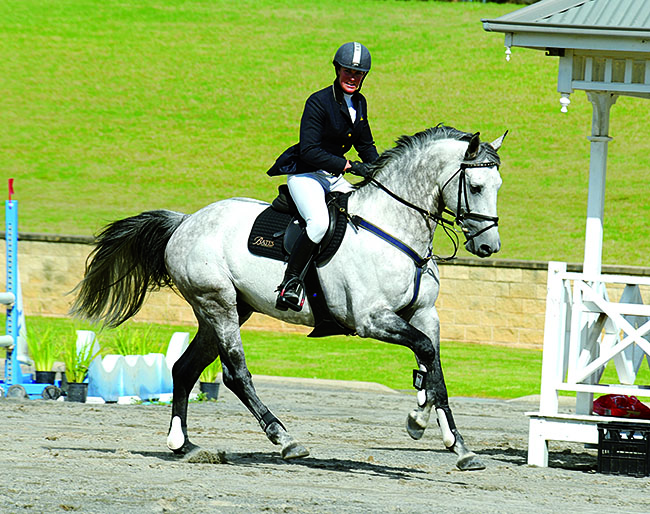You’ll often hear people talk about ‘seeing a short one’ – just what do they mean?
Let showjumping coach, Michelle Strapp explain:
If the horse is travelling down to a fence, and there is what we call an open option where the distance is a little further away, all of a sudden the rider will take hold, and add a stride… seeing a ‘short’ distance.
Generally we don’t like to see short distances – or do we?
There is nothing wrong with a short distance, it depends on how it is produced. So if you end up with a short distance, and your canter matches the short distance, three or four strides out, or six strides out – then we can call that a short option within your canter – and there is nothing wrong with it. But if you come in at a twelve foot canter stride and suddenly you end up doing a six foot last canter stride, then the canter is not symmetrical in the last strides, and that is when it is not a good thing.
We want a shorter stride when we are jumping verticals?
Verticals are more often jumped on a shorter stride because a rider finds it easier to balance and elevate a shorter canter so it matches the horse’s peak of its jump which is a lot higher over a tall vertical. The shorter stride could match a shorter distance if you have two verticals with a short stride in between.
A vertical can also be jumped from a longer stride, for instance, against the clock. However for this to be successful the big canter has to be coming from the back legs not running on the front legs so the horse can get the peak of the jump over the top rail.
A balanced distance
Riders need the option to ride a fence on a big stride or short stride …… you have a course like the World Cup at Equitana, there was vertical / oxer with two short strides in the middle. Because it was 1.50 metre oxer, the horses had to be able to close their canter on a shorter canter yet still have the power to jump the oxer, so that means the quality of your short canter still has the jump in it, and the power in it, and that’s where horses can get into trouble – because the rider shortens the canter and it is behind the leg – resulting in a weak canter .
Jeroen Dubbledamm and Zenith show how to tackle a double and become European Champions…

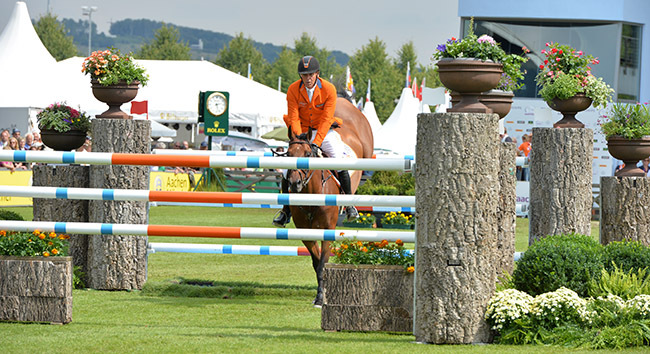
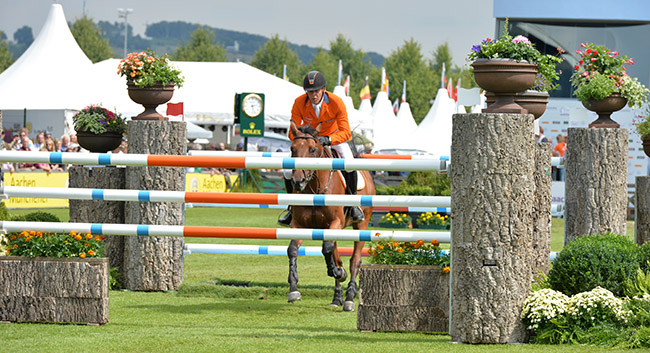
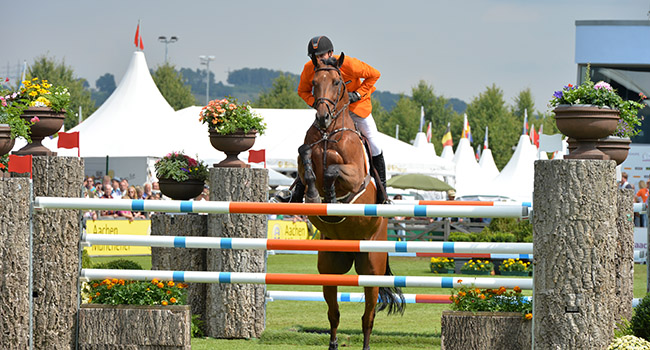
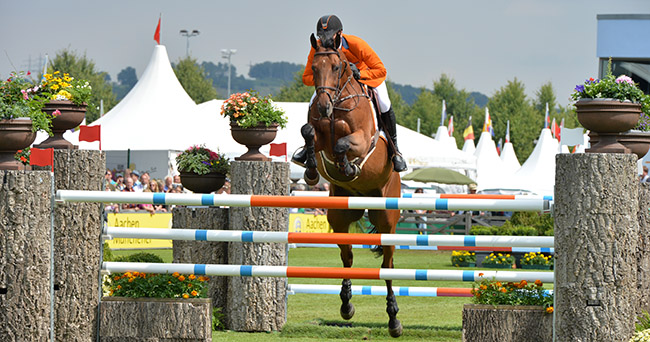
more follows
And when you take off from a long way away – that’s the reverse?
You could say, it was a long spot, or the horse has ‘let drive’ from a long distance. Quite often it is because the horses end up with much too much freedom between hand and leg, so the rider’s connection between hand and leg has such a big gap, that the horse’s natural instinct – when it gets long – is to see that distance. The horse will either let drive because they have enough speed (rather than power) in that long, floppy canter, or they will “chip” where it is a miss (meaning the rider has mis-judged the take off) – the rider is a little away and expecting the horse to leave the ground, and at the last minute, the horse will do a little chip stride.
Or a drive with no chip in
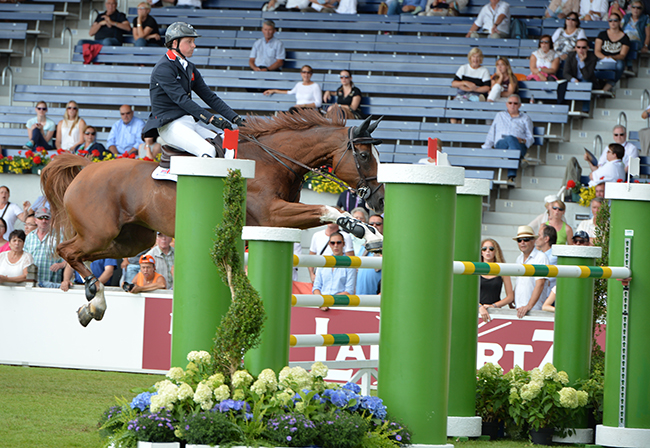
It all comes down to getting an established, even, canter?
Sure, the answer is to improve the quality of your canter so the horse is more secure between hand and leg – so you have more strength between hand and leg, then you have better options for your distances.
But sometimes people let drive because they are not patient enough to wait for the distance. It’s not only the horse that has a tendency to see that option, the rider may start accelerating because they are not comfortable to wait. A lot of riders aren’t comfortable to wait because they have never ridden in a canter that is good enough to wait.
Those riders always get what we call the ‘chase’ distance. They chase a horse and then they start to ride a distance with their upper body. They will see a long distance and start throwing their body at that distance… and then letting drive because they are not confident to wait with their body for the second option.
Isn’t that a George Morris maxim – if you see a long distance, wait and a better one will come up?
Take the second option…
With jumping it’s two opposites: you have to have the horse in front of the leg and forward to see a distance, but also waiting – you have to feel that your horse is going past you a little bit, that it is taking you to a distance and you have to be patient and wait with your upper body.
What happens is you teach a rider to get the horse in front of their leg and learn to mentally ride forward to a fence, not to see these wild long ones because they are not willing to be patient and see the next one.
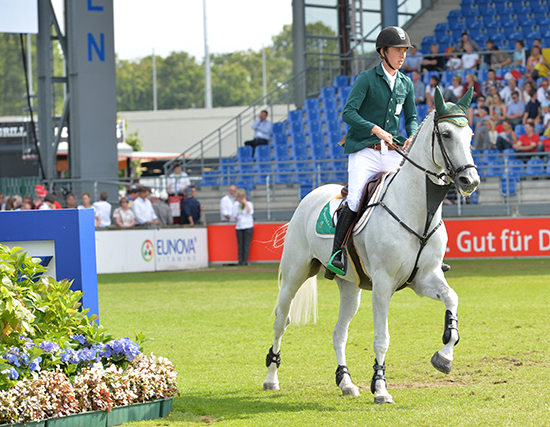
Have trust in waiting
They are not confident and want to grab whatever they can see – it’s a bit of a panic eye. “Gee, I’ve seen one, thank god, let’s take it.” They have to learn to have more trust in waiting, and to start to feel they are containing their canter for the second option, not stopping it.
What exercises can riders do to get their eye in so they can ride a better distance?
I think the most important thing in the beginning, is to get them sitting on a canter that is going to work. Timing is something you develop, you need exercises to get them understanding what a large influence your canter has in seeing a take off spot.
more on being in the right spot follows
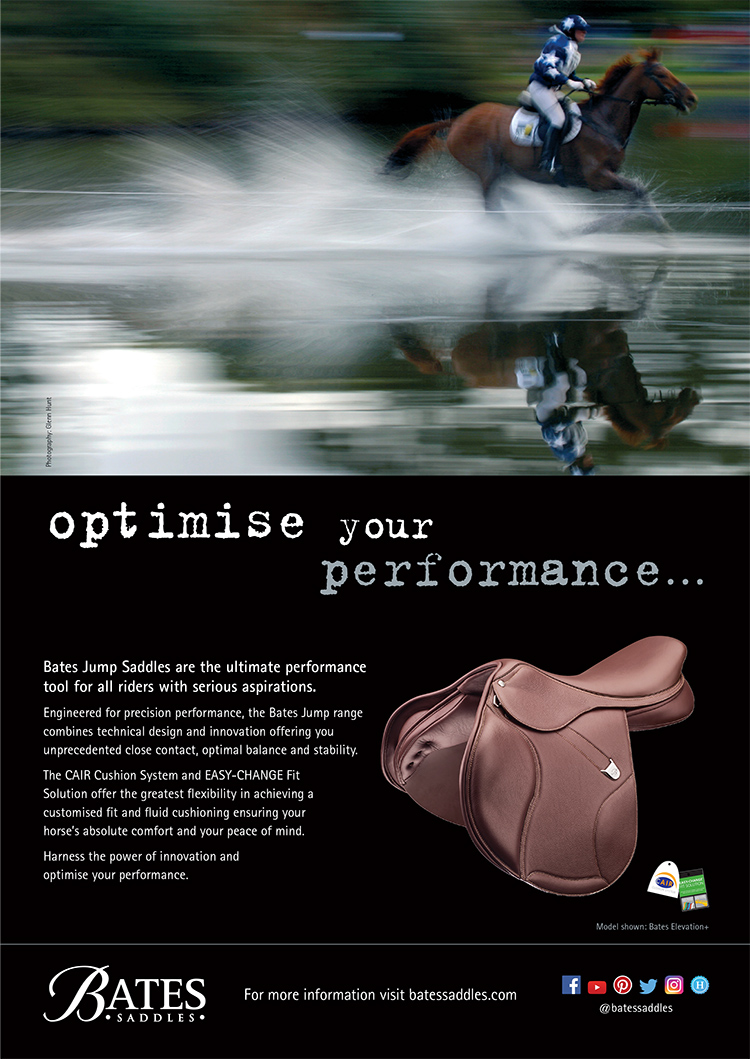
Cantering down to a single fence, I get them to tell me what option the canter produced at the fence every time they land. I just let them come in with the canter they think is good enough to jump the fence and then they start to say, well that canter brought me really long and flat. And you say ‘exactly’, and give them some flat to change the canter then reapproach and repeat the exercise. Then they start to realise – quite quickly – that the canter can produce a deeper distance, a longer distance or be so strung out it will produce nothing unless they start to pull it around the last 3 or 4 strides which we do not want… (which could be called breaking the canter or checking to find a distance)
When they learn to produce a good canter it has to become instinct because on course they can’t be thinking about it. A very good jumping rider is one who can feel the canter eight strides out, it’s just going to produce a distance. The canter feels us if they can open or close it, and the power level stays – the torque in the canter is really important. I sometimes get riders to canter down, and within that canter actually tell me what their option is, three or four strides out. This helps them read their canter better and with more focus.
Often riders don’t think about it – they’ll canter to a fence and they have so many things on their mind, they haven’t thought to read what option the canter can deliver, so they lose focus.
Australian riders once had a weird concept of ‘seeing a stride’ which involved lots of interference, bouncing up and down in front of the fence…
Checking was what they called it. A lot of the riders didn’t know how to produce a canter but they understood they needed bounce to see a distance – it’s like what you see human high jumpers do in the last few strides before a jump, the stride gets more springy.
So some Australian riders figured out that they needed spring to see a spot – and they took it to the other extreme. They came around the corner, got the revs, and then went bounce, bounce, and the horse felt really springy, and then they picked an option out of that. The problem with the bounce bounce approach is that the horse becomes inverted and unsettled.
We like to put our horses between leg and hand with a round, over the back, soft outline so you produce a lovely round soft jump off the floor.
more follows
Those riders were putting their horses between leg and hand in a whole different fashion..
– their way of getting the horses between hand and leg was to bring their heads up high with big bits and use the big spurs, sure they got bounce but it was inverted, the opposite of what we want to do but it created the distance, and it created the jump – because the jump is the product of your last three strides, always.
It wasn’t an ideal way of seeing a distance, but those riders had found their own way because there wasn’t anyone coaching who could help. They just found their own way, they had a bit of talent and feel and discovered a way they could find distances.
I think it was something Bill Steinkraus said when he came to Australia in the early 80’s – he said, the only way you can ride around this course is because your horse is going from jump to jump, if I took out the jumps you couldn’t ride the line of the course… he said what was important was how the horse travelled between the jumps, not what happened over them, but very few of the riders of the time related to what he was saying…
It was only a lack of understanding of what produced a better distance and fence… The flat work training often had no relationship to what they needed to ride a fence. I will always suggest to pupils who first start with me to never do flat without poles. They train in a canter that does not produce a distance and are not yet aware of this. If you give those students a pole to ride on the ground, they start to change the quality of the canter to enable them to source a more consistent distance.
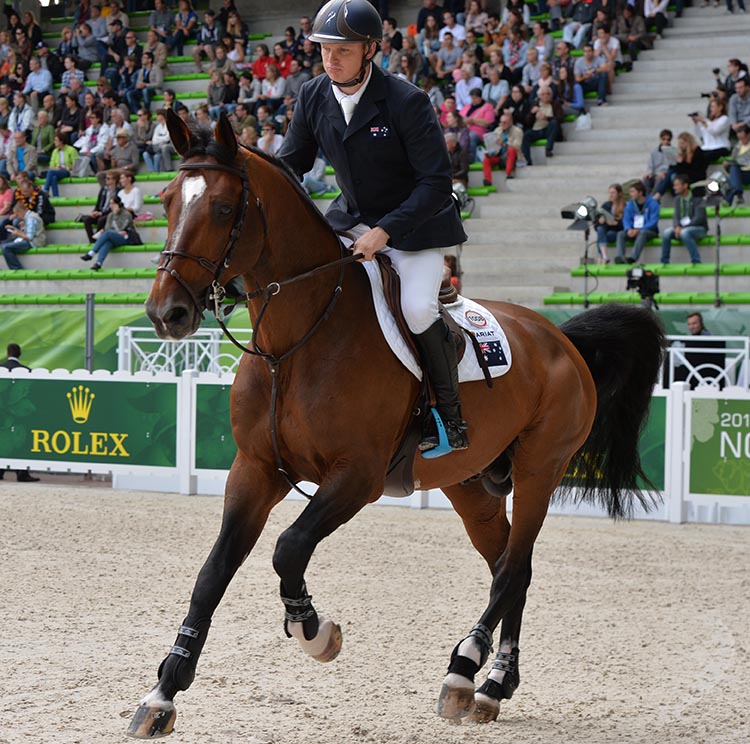
Are you more ‘picky’ now about the quality of canter you will accept?
In this industry you never stop learning. It’s like I loved watching the dressage master class at Equitana, because you can never learn too much. I don’t think I’m fussier about the canter but I think my knowledge is greater. I was always an over-perfectionist and my first training was on the flat – so I always knew that my canter was seriously important. My coaches – George Sanna, told me that, and Marion Gilchrist who I did flat work with, and then I went on to George Morris, Steinkraus – I did all their clinics so I was always very aware and I think I was always a bit of a man-made rider. Was I as talented as a Gavin Chester? I don’t think so, but I had a lot of knowledge of how I wanted them to go, it allowed me to produce horses and give them good rides.
Can you make a canter?
It helps your job if they are born with it. I think you can really improve a canter, and I think a lot of the dressage training I did when I stopped jumping for a while, taught me how to improve a canter because I think even before I did that dressage training I realised I was trying to produce canters from the front – not from behind. If you have a horse with a weak canter and you are able to ride them from the back, and always ride you canter forward to a very good half halt in the front, then you can improve canters. Amy Graham’s Transatlantic had a very weak canter and he travelled short in the neck and not straight. We have improved his canter out of sight, and her feel has improved. You can improve canters by getting them straighter, getting them more from the back, you definitely can improve them.
How far do you go down that dressage road with your jumping horses – would you do working canter pirouettes for example to improve the canter?
Absolutely. Any of the flat work I do, I wouldn’t judge it as a dressage test movement, so if we do a canter pirouette, we are not so fussy as if we were doing it for a test, but we definitely do training pirouettes. We do that with Charlie (Transatlantic), you won’t stay in it very long because you don’t want to stifle your canter. We spend a lot of time coming into a canter short enough for a canter pirouette, but then getting out of it very quickly.
I’ve never ridden Grand Prix dressage but my feeling is that it would be the same training for that, because I think riders can canter too short for too long, and the canters get stifled. A lot of it is always feeling that your horse is always taking you forward – when you start to do some shorter canter, if that horse is falling behind the leg or the hand, or the rider is having to be too active to drive it – then it is important that we work back in the canter where the horse is starting to take you.
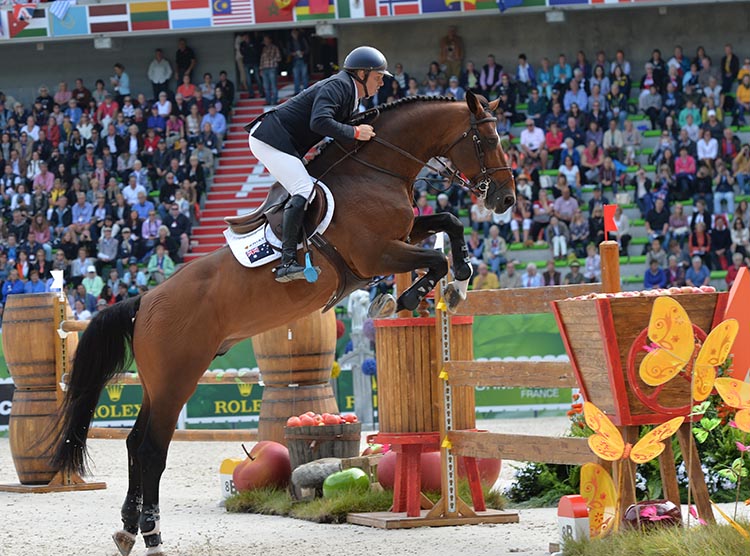
In the right place, Jamie Kermond at the WEG in 2014
If you come to a jumping fence you want to be able to wait and if you are waiting on a short canter, the horse has to be in front of your leg. So if you train them in a short canter and all you do is push, and push, and push to keep that short canter, then you can’t wait at a distance because it’s not in front of you.
You can only wait at a distance if the horse is taking you – whether you are on a four foot stride, five foot stride or 12 foot stride, it doesn’t matter, the horse has to take you.
You grew up riding Thoroughbreds off the track, how different is it when you get something like Baloubet Australis, concentrated jumping blood, to play with?
His canter is just natural canter, it’s totally different – more ground covering, but when they ground cover, they have more elevation and suspension – that’s the biggest thing. That’s why with a Thoroughbred if you canter down a five and a half stride line, and you do it in five, by the time you get to the next fence, you are flat ( with some exceptions). Thoroughbreds have a tendency to lower because they are bred to gallop.
It’s just a total luxury to ride horses like Baloubet because you feel when you open up your distance, you are actually getting more off the ground. You think you could gallop at 400 metres a minute to a 1.60 vertical sitting out there, and if you keep the horse balanced, you feel you’ve got the same jump as you have at 250metres a minute. That’s what gets bred into them, the jump and elevation in the canter, it just makes the jump so much easier. To compete at international level now, to make the time around a big track, you have to be moving – and with the Thoroughbreds, you are having to break the canter to keep the suspension in the stride.
With these horses that are bred for it, it’s like sitting on a big rocking horse. As long as the horse is very obedient between hand and leg & you can control that power. A horse like Baloubet has got all that power, and if he is not obedient, that power will work against you.
It’s not so much seeing a stride, as finding a canter…
Totally, your eye should complement your canter, your eye works within the canter you are riding rather than working the other way around. You don’t have an eye and then fit the canter to your eye – which is what some riders try to do. It really all comes down, every time, to the quality and control of your canter, get that, and it is easy to find a distance…
This story originally appeared in the February 2009 edition of The Horse Magazine
There are lots more articles with Michelle on this website, like this one:
Or to see a directory of all Michelle’s articles, go to her Who’s Who…







